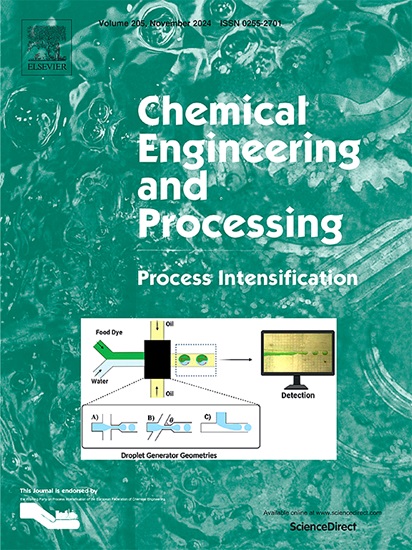Electrocoagulation with aluminum screen mesh electrodes for oil removal from oil-in-water emulsion
IF 3.8
3区 工程技术
Q3 ENERGY & FUELS
Chemical Engineering and Processing - Process Intensification
Pub Date : 2025-01-21
DOI:10.1016/j.cep.2025.110188
引用次数: 0
Abstract
Concentric cylindrical mesh screen electrodes were effectively used in the electrocoagulation (EC) method to treat machine oil effluents in a static batch system. A 3² experimental design was used with electric voltage (Va) and polarity inversion time (tpi) as input variables. Therefore, this work focused on the optimization of power consumption, electrode mass loss, oil content, and turbidity, maintaining pH within international standards. Monitoring pH evolution provided insights into the EC kinetics. This innovative geometry achieved a low energy consumption of about (2.5 ± 0.4) W, a specific energy requirement of (2.2 ± 0.2) kWh/kg for an oil content reduction of (91 ± 4) % and (97 ± 2) % turbidity reduction. These results stemmed from factors like the fast kinetics described by a Boltzmann sigmoidal function and the lack of a passivation layer to increase power consumption. Therefore, our results bring a strong contribution to treatments in static batch processes of oil emulsions in effluents.

求助全文
约1分钟内获得全文
求助全文
来源期刊
CiteScore
7.80
自引率
9.30%
发文量
408
审稿时长
49 days
期刊介绍:
Chemical Engineering and Processing: Process Intensification is intended for practicing researchers in industry and academia, working in the field of Process Engineering and related to the subject of Process Intensification.Articles published in the Journal demonstrate how novel discoveries, developments and theories in the field of Process Engineering and in particular Process Intensification may be used for analysis and design of innovative equipment and processing methods with substantially improved sustainability, efficiency and environmental performance.

 求助内容:
求助内容: 应助结果提醒方式:
应助结果提醒方式:


